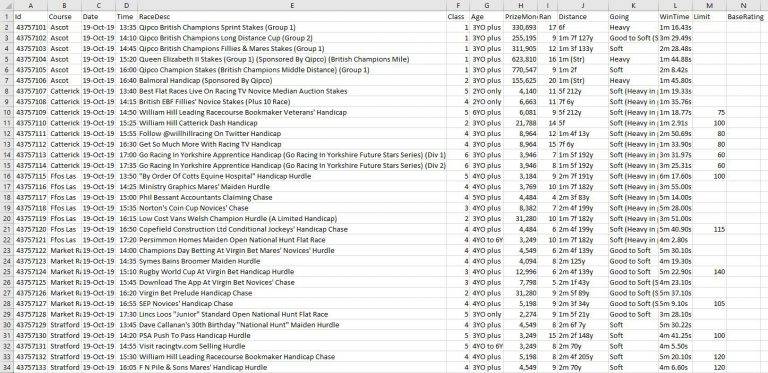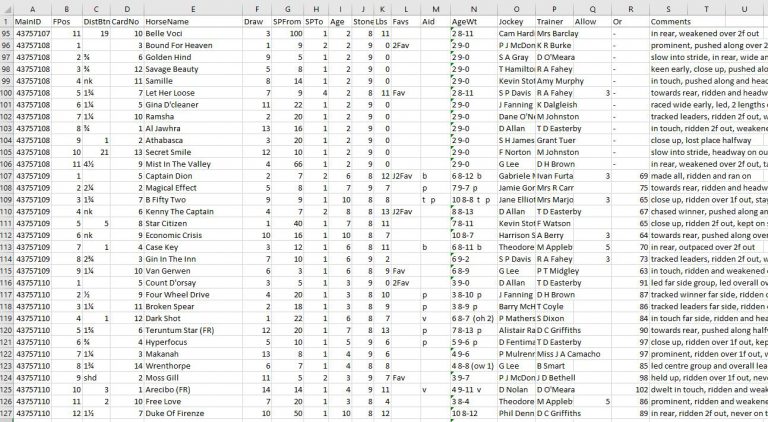Racing Form Book Results Data Files
If you ever wanted to be able to investigate horse racing data, whether this should be to study form or carry out research, then having a pool of racing results files is vital. At RacingFormBook we provide the results of each days racing from United Kingdom and Ireland in concise but thorough CSV files. Not only do we continually update the results data daily, but we have a back catalog of previous years. Visit the Past Racing Results page to see how simple is it is to obtain a large amount of historical data. Thereby putting you in a strong position very quickly to get going with your chosen studies.
The RacingFormBook results data files come in CSV format, as this is by far the most common means of transferring data between applications and systems.
We do provide the results data in two formats and there are know as:-
- Duo Format
- Single File Format
In addition we provide a cut-down version of the Duo format which are totally Free, but as the name suggests, contain less information. The Basic Data Files are explained here…..
Read the following page about the Single File Format where the results are available in CSV and soon an Access database
Horse Racing Results Files Explained
Here we look at RacingFormBook racing results files and detail the data and type of information contained within them.
Why are they a ‘Duo Format’?
We call the data files ‘Duo Format’ as they are more compatable for using with databases, which was the design point for them.
There are two files, one which contains the conditions of the race and a second which hold the information about each runner that raced in the event.
This format is also compatible with the our horse racing application RaceHorseFormBuilder which provides a way of creating your own ratings and storing them, along with the results in a database.
Racing Results Data Files Contents
We now discuss the ‘Duo’ format data files which as just mentioned are two CSV files. A brief description of both these files is given below and if further information is required, use this Contact Us link and I will endeavor to answer any direct questions.
File Naming Standardisation
To keep each days files unique they are are prefixed using the following numbers:-
yy (year)
mm (month)
dd (day)
As an example the January 1st 2020 would see the datafiles named 200101Main.csv and 200101Details.csv. The naming convention assists with sorting and listing by newest date first, as it ends up the highest number.
The two files for the ‘Duo’ format are known as main.csv and details csv. Each file is explained in turn with information about their column or field content.
MAIN.CSV
This file is the conditions of a race and contains the following field or columns, for which the image below shows the typical data.
ID This is the unique RFB reference for each individual race
Course The racecourse the race took place at
Date Date that the event took place on
Time Time the race was scheduled to start
RaceDesc The race title as seen on a racecard as a race description
Class Currently this is the class allocated as a figure from 1 – 7, with 1 being the top class races and 7 the lower class ones
Age Single or a range of restrictions for a race, where the race conditions are set by the age of the horses
PrizeMoney The currency value to the winner of the event. This is by the local currency, Pound for the UK, Euro for Ireland typically
Ran Number of horses that took part and competed in a race
Distance The distance in Miles, Furlongs, Yards that the runners raced at
Going The ground that race was run over
WinTime The recorded time that a race took to run
Limit Any race that was restricted to a specific ‘Official’ handicap range or upper limit
Base Rating Used to enter the Winners rating.
This last column is also intended for onward use with our RaceHorseFormBuilder App. It can of course be left blank, but more relevant for you is that you can put your own personal rating here. The RaceHorseForm Builder application helps rate every runner in a race and then subsequently the information is imported into a database. See here for more details
Click to expand the image of the main.csv to see the typical data.
DETAILS CSV
The Details CSV file contains the performance information regarding each individual runner in a race in the following fields/columns.
MainID Cross references to the Id column in the Main CSV file to link the two together
FPos Finishing position for each runner
DistBtn Finishing distance behind the horse which was immediately in front of them
CardNo The number on racecard allocated to each horse
HorseName The racehorse name and (country of breeding)
Draw If starting stalls used, the one a horse started in
SPFrom The ‘From’ part of the starting price
SPTo Corresponding ‘To’ part of the starting price
Age How old the horse was at the time of the race
Stone The weight in stones carried by the horse
Lbs The weight in pounds carried by the horse
Favs Used to denote the Favorite & second Favorite in the betting
Aid Any aids that the horse wore such as blinkers and if for a first time
AgeWt The Age, Weight and Aids detailed, plus Overweight and Penalties
Jockey Name of the Jockey who rode the horse
Trainer Name of the Trainer who trained the horse
Allow Any weight allowance the jockey was claiming
Or The Official handicappers rating
Comments Descriptive details on how the horse ran
Below is a screenshot example of how this data is presented after being imported into a spreadsheet, click the image to expand.
Obtaining The Files and Summary
That was the overview with details of the Duo Format.
These files are available the following morning after each days racing, though usually the evening before late on. We provide the files to our Subscribers at a reasonable cost.
A Basic format of the results data files are available at no charge, however these do not contain as much information and are available as a bi-weekly download. You do need to register with us to obtain them.
Clicking this Membership Options Page shortcut will allow you to take either of these options.
Why not obtain previous years from our Past Results Data page to have a comprehensive amount of data to work with.
Once you have the information in a database it is possible to carry out all manner of queries against it. In fact we have made an Access Database available which includes extended information using our ‘Single File’ format for the data. The extra columns of information comes directly from manipulating and calculating the data using the files as described on these pages. To see this extra information please view the Single File Format page which details them and we hope give an indication as to what you can do with this undeniable wealth of data.
Our mission
To further anyone’s ambition to use the information, whether this is as a point of reference, a repository for their ratings or to enable the research into racing systems.
Our offer
- Horse racing results CSV data files
- Provide Horse Racing Databases
- Formbook Builder Application
- Results data going back to the start of 2016


